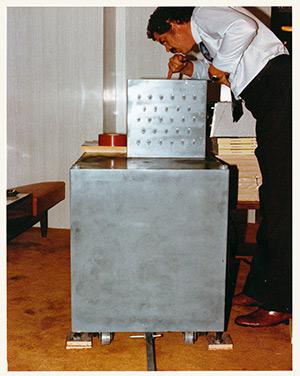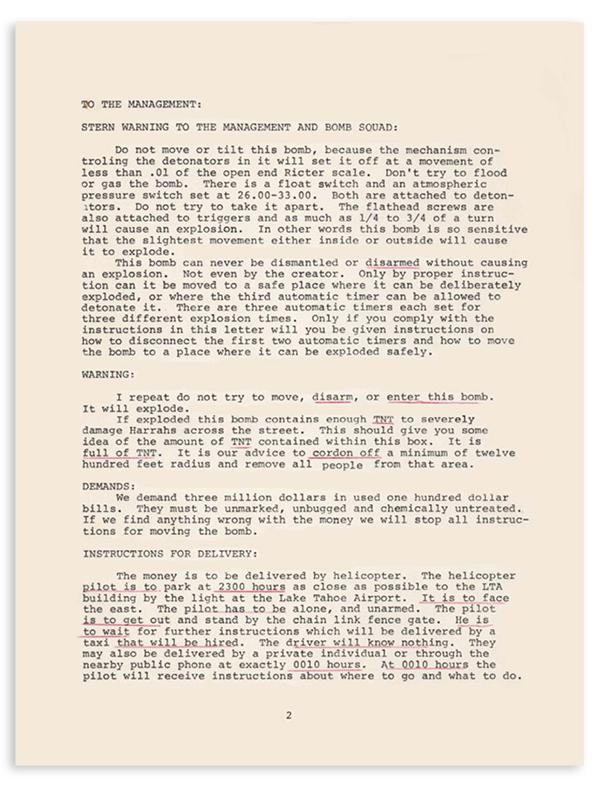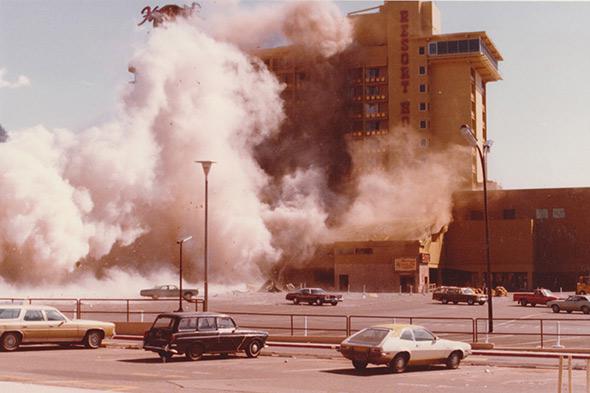This article is excerpted from “A Thousand Pounds of Dynamite,” the newest single from the Atavist.
It was about 5:30 a.m. on Tuesday, Aug. 26, 1980, when Bob Vinson, who supervised the graveyard shift at Harvey’s Wagon Wheel Casino in Stateline, Nevada, realized he was out of cigarettes. He was on his way down from his second-floor office to the gift shop to buy a pack when he noticed something odd. The accordion door leading through to the room that housed the casino’s internal telephone exchange was half open. It was usually closed, and he hadn’t seen anyone else around. He was curious. He stepped around the door and looked inside.

Courtesy of the Federal Bureau of Investigation
There was a big gray metal object sitting there, right outside the phone exchange. It hadn’t been there 20 minutes earlier. It was on metal legs. The legs were all balanced on pieces of plywood. They were pressing into the thick orange carpet. Whatever it was, it was heavy, and he was pretty sure it didn’t belong there.
The security supervisor that morning was Simon Caban, a big man who had been a helicopter door gunner in Vietnam. By the time Caban arrived on the second floor, a few janitors and security guards had gathered around the phone exchange; calls had already gone out to the Douglas County Sheriff’s Department and the fire department. When he saw the strange machine, but especially the envelope lying on the carpet next to it, he was alarmed. He’d just taken a training course on letter bombs. “Everybody step back,” he said.
Caban and a sheriff’s deputy grabbed a pair of the janitors’ broomsticks and, taking cover behind the big gray box, used them to poke at the suspect envelope. It was lying face up. It wasn’t sealed. It didn’t look dangerous. Inside were three pages of type. Caban picked up the one with the least amount of writing on it. The deputy grabbed the other two. They started reading at the same time. Caban didn’t have his glasses with him and found it hard to focus on the page. He was leaning on the box. The deputy was squatting on the floor at his feet. Caban was about to tell the deputy to give him the rest of the letter when he pointed up at the box. “That’s a bomb,” he said. Slowly, Caban lifted his weight off the contraption and backed away.
* * *
The deputies met FBI Special Agent Bill Jonkey in the parking lot at Harvey’s, where the evacuation had already started. The hotel was full to capacity with vacationers in town for Labor Day weekend. On the casino floor, security guards were emptying the cage of the $2 million or $3 million in cash held there and figuring out how to lock the doors of a building that had been open 24 hours a day for 17 years.
Jonkey met Danny Danihel, captain of the Douglas County fire department’s bomb squad, outside the phone exchange. Danihel, a former explosive ordnance disposal specialist in the U.S. Army who had also served in Vietnam, was supposed to be off for three days starting that morning. He was packing for a camping trip with his family when he got the call.
The fire department team was still bringing equipment up from the parking lot when Jonkey arrived. Jonkey’s first thought was how well made the bomb was. The welding, the seams, the paint job—the thing was beautiful. None of the bomb-squad guys had seen anything like it. And there didn’t seem to be any way into it. Then they showed Jonkey the letter.
“Stern warning to the management and bomb squad,” it began.
Do not move or tilt this bomb, because the mechanism controlling the detonators will set it off at a movement of less than .01 of the open end Ricter scale. Don’t try to flood or gas the bomb. There is a float switch and an atmospheric pressure switch set at 26.00-33.00. Both are attached to detonators. Do not try to take it apart. The flathead screws are also attached to triggers…
WARNING:
I repeat do not try to move, disarm, or enter the bomb. It will explode.
This mixture of stentorian threats and technical minutiae continued for three pages. The bomb was filled with 1,000 pounds of TNT, the letter explained, enough to not just obliterate Harvey’s but also to severely damage Harrah’s Casino across the street. It was equipped with three separate timers. The letter advised cordoning off a minimum of 1,200 feet around the building and evacuating the area. “This bomb can never be dismantled or disarmed without causing an explosion,” it said. “Not even by the creator.”

Courtesy of Bill O’Reilly
The letter’s author was demanding $3 million in used $100 bills, delivered by helicopter to intermediaries, with further details to follow. In exchange, instructions would be provided for how to disconnect two of the automatic timers so the device could be moved to a location where it would explode harmlessly. There was a tight deadline: “There will be no extension or renegotiation. The transaction has to take place within 24 hours.”
The note concluded with a message for the helicopter pilot making the ransom drop. “We don’t want any trouble but we won’t run away if you bring it,” it said. “Happy landing.”
The letter, like the device itself, was unlike anything Jonkey had seen before. Some of the claims were ridiculous; that stuff about the “Ricter scale” was obviously bullshit. And when Danihel’s bomb squad took measurements of the device, they concluded that it wasn’t quite big enough to contain 1,000 pounds of TNT. But when Danihel began shooting X-rays of the box, Jonkey saw evidence of a chilling complexity within.
There were wires connected to the 28 toggle switches and to the screws, just as the letter said. There were also triggers that weren’t mentioned in the note: a possible collapsing circuit, a relay and the outline of pressure-release switches, triggers with what looked like crude metal paddles on the lids of the boxes. And whatever was in the bottom box, there was so much of it that it almost filled the space inside, and it was so dense that Danihel’s portable X-ray machine couldn’t penetrate it. Nobody would go to all the trouble of building a device of such sophistication just to give it a payload of kitty litter. Jonkey and Danihel couldn’t be certain, but it seemed entirely possible that they were looking at the largest improvised bomb in U.S. history.
* * *
For the first 24 hours, Danny Danihel had felt pretty comfortable with the bomb. A device that big could easily bring the entire building down, but he knew that no sensible extortionist would blow up his target before he’d gotten his money. Since the midnight deadline had come and gone, the situation was different. Now the thing could go off at any moment. And Danihel still had dozens of questions: When did the timer start running? How accurate was it? How reliable were the batteries? How good was this guy’s wiring? Was he really an expert or just some nut job who wanted people to think he was?
At 9:30 a.m. on Wednesday, the experts gathered in the Sahara command post for a roundtable meeting. They threw out every idea they could come up with. Flood the bomb with liquid nitrogen. Encase it in concrete. Pick it up and carry it to a nearby golf course. Finally, Leonard Wolfson, a civilian consultant to the Navy, suggested using more explosives to defeat the bomb, with a linear shaped charge. A precisely formed piece of plastic explosive encased in a brass jacket, it would create two explosive planes of hot gas collapsing on one another to form a fine jet: a pyrotechnic cutting tool. This could disable the bomb by severing the fusing mechanisms the technicians could see in the top box from the explosives they believed filled the lower box. Wolfson explained that the time between the detonation of the charge and the gas jet striking the box would be half a millisecond. If the bomb contained only low-voltage circuitry, it would be decapitated before the electrical impulses from the battery could reach the detonators and trigger the dynamite. It was risky, but it was the best idea they had.
At 3:10 p.m., Danihel walked up to the bomb carrying the shaped charge taped to a two-by-four. He had been awake for 30 hours. He was very tired and very scared.
Standing beside the bomb, he positioned the charge against a stack of Tahoe phone books and a Formica-topped table. He primed the charge and checked the detonators. He checked the continuity of the firing leads with a galvanometer. He had only one shot. He didn’t want to have to come back up on this thing. He made the connection to the firing leads. Then he checked everything again.
The sheriff’s office announced a 15-minute warning. Crowds of gawking tourists and reporters craned their necks from behind the barricades. Some of them were already wearing “I Was Bombed at Harvey’s” T-shirts. Word went around that gamblers were placing bets on what would happen next.
Danny Danihel walked down the frozen escalator, past the blinking slots, and out into the afternoon sun. The empty street rang with the sound of a deputy calling out a final warning over the PA of his patrol car. Then silence, save for the clicking of the stoplights on Stateline Avenue. Danihel’s radio crackled with the final OK. He touched one of the two strands of firing lead against a truck battery. “Fire in the hole,” he said. He touched the second strand to the battery. It was 3:46 p.m.
“Holy shit,” Danihel said. But nobody heard him over the roar of the explosion.
* * *
Fragments of concrete and pieces of plaster rained from the sky. On the roof of the Sahara Tahoe, Bill Jonkey sheltered behind a shallow parapet. Fragments of wood, metal, and glass sprayed out from both sides of Harvey’s as the bomb vaporized in a flash of superheated expanding gases. A pressure wave radiating outward at more than 14,000 feet per second tore through the second floor, bursting through doorways, flattening walls, and shattering windows. A curtain of brown smoke fell across the facade. A cloud of white dust blossomed from the second floor, enveloping the building and rolling across the parking lot. Behind the barricades, a ragged whoop went up from the crowd.

Courtesy of Bill Jonkey
Danihel lay on the warm asphalt, waiting for the patter of debris falling on the roof of the truck to subside. From within the building came sounds of rending and crashing as floors and ceilings collapsed. When he finally stood, the damage wrought by nearly 1,000 pounds of dynamite was clear. A jagged five-story hole yawned in the middle of the casino. “We lost it,” Danihel said. “The whole thing went up.”
* * *
When the charge went off, Chris Ronay was standing on Stateline Avenue, still in his suit and tie. He had come straight from the FBI Explosives Operations Center in Washington, where he worked as a bomb analyst.
The concussion of the explosion knocked Ronay to the ground. Beside him the state fire marshal shouted “C’mon!” and took off running toward the hotel lobby entrance. Ronay followed. Plaster dust was still drifting in the air.
The explosion had torn a giant spherical hole through the middle of the hotel. The void reached up to the fifth floor and all the way down into the basement. Around it, webs of twisted rebar were tangled with broken drywall, bedclothes, and pieces of metal window frame. Toilets teetered on the edges of newly calved precipices. TV sets dangled by their cables over the abyss. Water poured from broken pipes, soaking everything. From somewhere deep inside the darkened carcass of the building came the distant sound of whirring machinery, still drawing power from an auxiliary generator no one had thought to shut off.
Ronay looked down at the dust carpeting the parking lot. His job was just beginning.
This article is excerpted from “A Thousand Pounds of Dynamite,” the newest single from the Atavist.